How To Install Samsung Gas Stove
How to Install a Gas Stove—Without Dangerous Leaks
Install gas appliances correctly
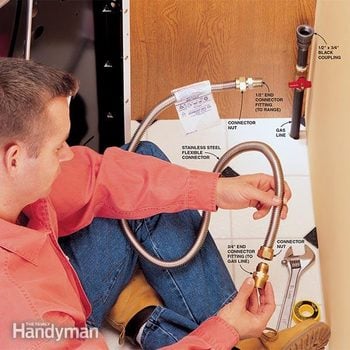 Family Handyman
Family Handyman
Afraid to hook up a gas appliance? You should be! A gas leak in your home can be fatal. Here's the right way to connect a range and a water heater to the gas line.
You might also like: TBD
- Time
- Complexity
- Cost
- A full day
- Beginner
- $51–100
How to hook up a new gas stove and range
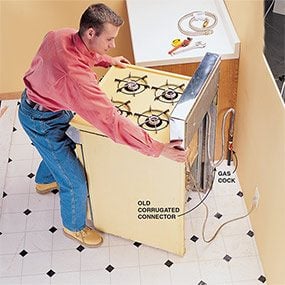
Photo 1: Pull out the range
Pull out the range, and shut off the gas cock (see also Photo 2). The gas is off when the lever is at a right angle to the pipe. This shutoff may be located behind the range, or in the basement just below. A shutoff is required in the line to the range, and should be added if you don't have one. Don't forget upkeep, learn how to clean a stove top the best way.
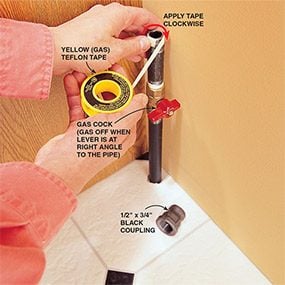
Photo 2: Wrap the pipe threads
Wrap Teflon pipe-joint tape twice around the threads in the same direction that the fitting screws on (clockwise). Yellow Teflon tape, heavier than white, is meant for gas fittings. The 1/2-in. x 3/4-in. coupling accommodates the 3/4-in. end connector fitting (Photo 3), since connectors with 1/2-in. end fittings at both ends are not always readily available.

Photo 3: Screw the connector to the gas line
Remove the end connector fitting, wrap the unbeveled end with Teflon tape, and screw it to the gas line. This end fitting can be either male or female. ALWAYS use both of the removable end fittings. NEVER screw the connector nuts that are on the ends of the corrugated tube to a black gas fitting or pipe. This would be a guaranteed leak.
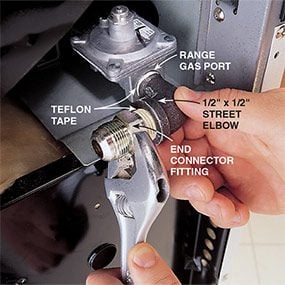
Photo 4: Use a street elbow
Screw a 1/2-in. x 1/2-in. street elbow (male threads at one end, female at the other) into the range gas port. Then screw the connector's other end fitting into the street elbow. Use Teflon tape on each fitting. Be careful not to overtighten, putting excess stress on the range's gas port fitting.

Photo 5: Tighten the nuts
Tighten the connector nuts to the two end connector fittings. While tightening the nuts, hold the tube straight against the fitting. Do NOT use Teflon tape on these threads. The beveled edges of the end fittings are meant to form a tight seal against the ends of the corrugated tube. Using tape can interfere with this seal.

Photo 6: Check for leaks
Turn on the gas cock (vertical position) and light the range burners for about a minute to get the air out of the gas line. Then spray all the joints you've made with gas leak detector (sold at home centers). You can also use warm, thick soapy water for this. Bubbles around a joint will indicate a leak.
Hooking up a gas range or water heater is a relatively simple job requiring just basic tools and readily available supplies. And if you use the right materials and follow instructions carefully, you can safely do the job yourself. A professional may charge as much as a few hundred dollars for a hook-up.
We'll show you in this article how to do two basic types of gas connection: hooking up a gas range using a flexible, corrugated connector (a gas clothes dryer is similar); and using threaded black steel gas pipe to hook up a water heater.
Flexible corrugated gas connectors and gas pipe and fittings (black) are available at most home centers and well-stocked hardware stores. Stainless steel or coated brass connectors are the only type of flexible connectors sold these days, and the only type you can safely and legally use. Older types of corrugated connectors—sold until the 1980s—made of uncoated brass or other metal have been found to be unsafe. Have one in your house? Replace it now!
The most important step to a safe installation is to buy the right connector. Here's what to look for:
- Buy a connector that is clearly marked for the appliance you're hooking up—either "range" or "dryer." Typically the corrugated tube of a range connector is 1/2 in. dia. i.d. (inside diameter), and a dryer connector is 3/8 in. dia. i.d. These dimensions are not always marked on the package, but they will be marked for either range or dryer.
- Buy a connector that comes packaged with the end connector fittings you need (see Photo 3). Usually the gas line coming into your kitchen will be 1/2-in. black threaded pipe, and the connection to the stove will be either a male (external threads) or female (internal threads) 1/2-in. fitting. If you cannot find a connector package with end fittings that match what you need for the gas line, use a black gas pipe fitting on the line to accommodate the end connector fitting. For example, in Photos 2 and 3, we show a 1/2-in. x 3/4-in. coupling on the gas line to accommodate the 3/4-in. end connector fitting. (For more possible connections and information about connecting to soft copper supply lines, see How to Connect Gas Pipe Lines)
- Use a connector that's plenty long so you'll have enough room to work between the stove and the wall. They come in lengths from 24 in. to 60 in.
- Don't reuse a flexible connector; if you get a new appliance, buy a new connector as well. Follow the instructions for installing the connector religiously. Our Photos 1 through 5 give a real-life picture of how this is done. Here are some additional guidelines:
- Be careful not to kink or force the corrugated connector into sharp bends, which could eventually cause a break.
- Always check your work for leaks (Photo 6). Gas leak detectors are sold at home centers, hardware stores and online.
- Although it's not always required to have a range hookup inspected,we strongly recommend that you call your local gas company or plumbing inspector to check your work.
Hook up a gas water heater

Photo 1: Shut off the gas
Shut off the gas cock on the line entering the water heater. It usually requires a one-quarter turn. When the lever is parallel to the pipe, the gas is on; at a right angle to the pipe is off. A gas shutoff is required in the line; if you don't have one, you'll need to install one.
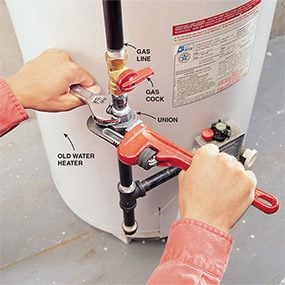
Photo 2: Unscrew the union
Uncouple the gas line at the union, a fitting that should be located somewhere below the gas cock, as shown here and in Photos 4 and 5. Hold back the top part of the union with one wrench as you unscrew the coupling section with a second wrench.
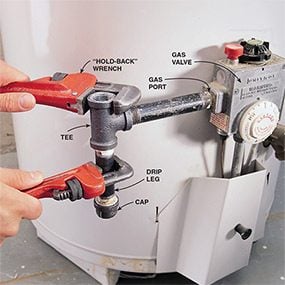
Photo 3: Unscrew the tee
Remove the two short vertical lengths of pipe that run above and below the tee fitting. Then unscrew the tee along with the short horizontal length of pipe running to the heater's gas port. Always use a second "hold-back" wrench, as shown here and in Photo 4, to prevent damage to the heater's gas port and gas valve. The "drip leg"and cap shown here is required to prevent debris from clogging the gas valve.
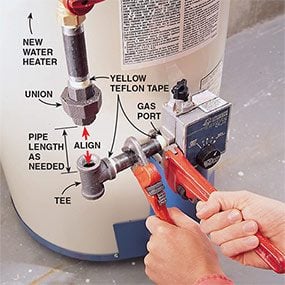
Photo 4: Reassemble the gas line
Reassemble the gas line in the same configuration as it was. If your heater's gas port is in a different horizontal location than the old one, you need to vary the length of the pipe being installed here to align the tee with the gas line. If the heater's gas port is in a different location vertically from the old one, you need to change the length of the pipe above the tee. Measure the distance, and allow an extra 1/2 in. at each end for the threads to screw in.
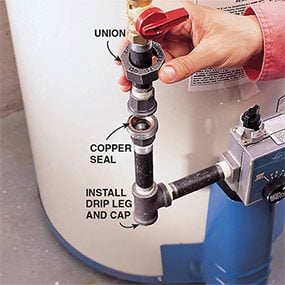
Photo 5: Reassemble the union
Reconnect the union. Note the copper seal that forms the gas-tight seal; make sure the pipe alignment is straight, so the two sections of the seal will join up properly. Then tighten the union as shown in Photo 2. Install the drip leg and cap as shown in Photo 3. Test for leaks.
The gas connection to a water heater is usually done with rigid 1/2-in. dia. black gas pipe. In some areas, it's acceptable to use a flexible stainless steel connector, similar to a range hook-up, but check with your plumbing inspector or gas utility first. Rigid pipe is preferable, since a water heater's gas line is exposed and more vulnerable to movement and damage.
In many cases, the gas port on your new water heater will be in the same location as the old one, relative to your gas line. This makes the hook-up easy: Just remove the short lengths of pipe and fittings, as shown in Photos 2 and 3, clean the threads, apply new Teflon tape to the threads, and reconnect the entire assembly exactly as it was before.
However, if the heater's gas port is in a different location, you will have to change the length of one or possibly two short lengths of pipe, as shown in Photo 4. Nipples—short lengths of black pipe—are sold at most home centers in 1/2-in. increments for the shorter lengths.
Here are some guidelines:
- Use yellow Teflon tape, intended for threaded gas connections, not white Teflon tape, which is thinner.
- Test all your joints for leaks.
- In most, but not all areas, a permit and inspection is required for a water heater hookup. In either case, we strongly recommend that you call your local gas company or plumbing inspector to check your work.
Required Tools for this Project
Have the necessary tools for this DIY project lined up before you start—you'll save time and frustration.
Required Materials for this Project
Avoid last-minute shopping trips by having all your materials ready ahead of time. Here's a list.
Similar Projects
How To Install Samsung Gas Stove
Source: https://www.familyhandyman.com/project/how-to-install-a-gas-stove-without-dangerous-leaks/
Posted by: iglesiascocam1971.blogspot.com

0 Response to "How To Install Samsung Gas Stove"
Post a Comment